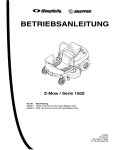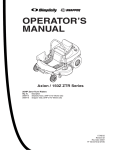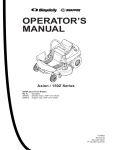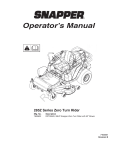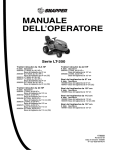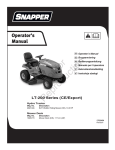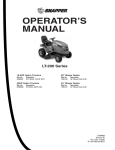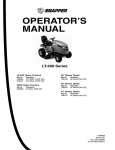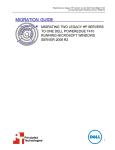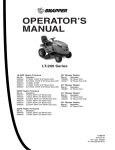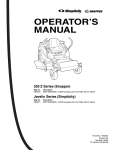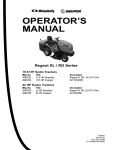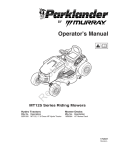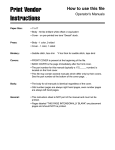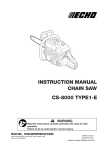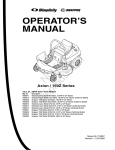Download Snapper Z-Mow / 150Z Lawn Mower User Manual
Transcript
OPERATOR’S MANUAL Z-Mow / 150Z Series Mfg. No. Description 2690611 Z-Mow, 18.5HP & 42” Mower (CE) 2690612 150Z, 18.5HP & 42” Mower (CE) 1733615 Revision 00 Rev. Date 11/2006 TP 100-4413-00-ZT-SN TABLE OF CONTENTS Safety Rules & Information.........................................3 Identification Numbers................................................6 Pre-Operation...............................................................7 Operation......................................................................8 Maintenance...............................................................15 Service & Adjustments .............................................24 Storage .......................................................................28 Troubleshooting.........................................................29 Specifications ............................................................31 NOTE: In this manual, “left” and “right” are referred to as seen from the operating position. 1 SAFETY RULES Read these safety rules and follow them closely. Failure to obey these rules could result in loss of control of unit, severe personal injury or death to you, or bystanders, or damage to property or equipment. This mowing deck is capable of amputating hands and feet and throwing objects. The triangle in text signifies important cautions or warnings which must be followed. GENERAL OPERATION 19. Follow the manufacturer’s recommendations for wheel weights or counterweights. 20. Keep in mind the operator is responsible for accidents occurring to other people or property. 21. All drivers should seek and obtain professional and practical instruction. 22. Always wear substantial footwear and trousers. Never operate when barefoot or wearing sandals. 23. Before using, always visually check that the blades and blade hardware are present, intact, and secure. Replace worn or damaged parts. 24. Disengage attachments before: refueling, removing an attachment, making adjustments (unless the adjustment can be made from the operator’s position). 25. When the machine is parked, stored, or left unattended, lower the cutting means unless a positive mechanical lock is used. 26. Before leaving the operator’s position for any reason, engage the parking brake (if equipped), disengage the blades (PTO), stop the engine, and remove the key. 27. To reduce fire hazard, keep the unit free of grass, leaves, & excess oil. Do not stop or park over dry leaves, grass, or combustible materials. 28. It is a violation of California Public Resource Code Section 4442 to use or operate the engine on or near any forest-covered, brush-covered, or grass-covered land unless the exhaust system is equipped with a spark arrester meeting any applicable local or state laws. Other states or federal areas may have similar laws. 29. OSHA regulations may require the use of hearing protection when exposed to sound levels greater than 85 dBA for an 8 hour time period. 1. Read, understand, and follow all instructions in the manual and on the unit before starting. 2. Do not put hands or feet near rotating parts or under the machine. Keep clear of the discharge opening at all times. 3. Only allow responsible adults, who are familiar with the instructions, to operate the unit (local regulations can restrict operator age). 4. Clear the area of objects such as rocks, toys, wire, etc., which could be picked up and thrown by the blade(s). 5. Be sure the area is clear of other people before mowing. Stop the unit if anyone enters the area. 6. Never carry passengers. 7. Do not mow in reverse unless absolutely necessary. Always look down and behind before and while travelling in reverse. 8. Never direct discharge material toward anyone. Avoid discharging material against a wall or obstruction. Material may ricochet back toward the operator. Stop the blade(s) when crossing gravel surfaces. 9. Do not operate the machine without the entire grass catcher, discharge guard (deflector), or other safety devices in place and operational. 10. Slow down before turning. 11. Never leave a running unit unattended. Always disengage the blades (PTO), set parking brake, stop engine, and remove keys before dismounting. 12. Disengage blades (PTO) when not mowing. Shut off engine and wait for all parts to come to a complete stop before cleaning the machine, removing the grass catcher, or unclogging the discharge guard. 13. Operate the machine only in daylight or good artificial light. 14. Do not operate the unit while under the influence of alcohol or drugs. 15 Watch for traffic when operating near or crossing roadways. 16. Use extra care when loading or unloading the unit into a trailer or truck. 17. Always wear eye protection when operating this unit. 18. Data indicates that operators, age 60 years and above, are involved in a large percentage of power equipment-related injuries. These operators should evaluate their ability to operate the equipment safely enough to protect themselves and others from injury. CAUTION This machine produces sound levels in excess of 85 dBA at the operator’s ear and can cause hearing loss though extended periods of exposure. Wear hearing protection when operating this machine. TRANSPORTING AND STORAGE 1. When transporting the unit on an open trailer, make sure it is facing forward, in the direction of travel. If the unit is facing backwards, wind lift could damage the unit. 2. Always observe safe refueling and fuel handling practices when refueling the unit after transportation or storage. 3. Never store the unit (with fuel) in an enclosed poorly ventilated structure. Fuel vapors can travel to an ignition source (such as a furnace, water heater, etc.) and cause an explosion. Fuel vapor is also toxic to humans and animals. 4. Always follow the engine manual instructions for storage preparations before storing the unit for both short and long term periods. 5. Always follow the engine manual instructions for proper start-up procedures when returning the unit to service. 6. Never store the unit or fuel container inside where there is an open flame or pilot light, such as in a water heater. Allow unit to cool before storing. TP 600-4103-01-ZT-UV 2 SLOPE OPERATION WARNING Slopes are a major factor related to loss-of-control and tipover accidents, which can result in severe injury or death. Operation on all slopes requires extra caution. If you cannot back up the slope or if you feel uneasy on it, do not operate on it. Control of a walk-behind or ride-on machine sliding on a slope will not be regained by the application of the brake. The main reasons for loss of control are: insufficient tire grip on the ground, speed too fast, inadequate braking, the type of machine is unsuitable for its task, lack of awareness of the ground conditions, incorrect hitching and load distribution. 1. Mow across slopes, not up and down. 2. Watch for holes, ruts, or bumps. Uneven terrain could overturn the unit. Tall grass can hide obstacles. 3. Choose a slow speed so that you will not have to stop or change speeds while on the slope. 4. Do not mow on wet grass. Tires may loose traction. 5. Never mow down slopes. 6. Avoid starting, stopping, or turning on a slope. If tires lose traction (i.e. machine stops forward motion on a slope), disengage the blade(s) (PTO) and drive slow off the slope. 7. Keep all movement on slopes slow and gradual. Do not make sudden changes in speed or direction, which could cause the machine to rollover. 8. Use extra care while operating machines with grass catchers or other attachments; they can affect the stability of the unit. Do not use on steeps slopes. 9. Do not try to stabilize the machine by putting your foot on the ground (ride-on units). 10. Do not mow near drop-offs, ditches, or embankments. The mower could suddenly turn over if a wheel is over the edge of a cliff or ditch, or if an edge caves in. 11. Do not use grass catchers on steep slopes. 12. Do not mow slopes if you cannot back up them. 13. See your authorized dealer/retailer for recommendations of wheel weights or counterweights to improve stability. 14. Remove obstacles such as rocks, tree limbs, etc. 15. Use slow speed. Tires may lose traction on slopes even through the brakes are functioning properly. 16. Do not turn on slopes unless necessary, and then, turn slowly and gradually uphill, if possible. Never mow down slopes. Never operate on slopes greater than 17.6 percent (10°) which is a rise of 3-1/2 feet (106 cm) vertically in 20 feet (607 cm) horizontally. Select slow ground speed before driving onto slope. Use extra caution when operating on slopes with rearmounted grass catchers. Mow across the face of slopes, not up and down,use caution when changing directions and DO NOT START OR STOP ON SLOPE. CHILDREN Tragic accidents can occur if the operator is not alert to the presence of children. Children are often attracted to the unit and the mowing activity. Never assume that children will remain where you last saw them. 1. Keep children out of the mowing area and under the watchful care of another responsible adult. 2. Be alert and turn unit off if children enter the area. 3. Before and during reverse operation, look behind and down for small children. 4. Never carry children, even with the blade(s) off. They may fall off and be seriously injured or interfere with safe unit operation. Children who have been given rides in the past may suddenly appear in the mowing area for another ride and be run over or backed over by the machine. 5. Never allow children to operate the unit. 6. Use extra care when approaching blind corners, shrubs, trees, or other objects that may obscure vision. EMISSIONS 1. Engine exhaust from this product contains chemicals known, in certain quantities, to cause cancer, birth defects, or other reproductive harm. 2. Look for the relevant Emissions Durability Period and Air Index information on the engine emissions label. TOWED EQUIPMENT (RIDE-ON UNITS) IGNITION SYSTEM 1. Tow only with a machine that has a hitch designed for towing. Do not attach towed equipment except at the hitch point. 2. Follow the manufacturer’s recommendations for weight limit for towed equipment and towing on slopes. See attaching a trailer under OPERATION. 3. Never allow children or others in or on towed equipment. 4. On slopes, the weight of the towed equipment may cause loss of traction and loss of control. 5. Travel slowly and allow extra distance to stop. 6. Do not shift to neutral and coast down hill. 1. This spark ignition system complies with Canadian ICES-002. 3 SERVICE AND MAINTENANCE 13. If the fuel tank must be drained, it should be drained outdoors. 14. Replace faulty silencers/mufflers. 15. Maintain or replace safety and instruction labels as necessary. 16. Use only factory authorized replacement parts when making repairs. 17. Always comply with factory specifications on all settings and adjustments. 18. Only authorized service locations should be utilized for major service and repair requirements. 19. Never attempt to make major repairs on this unit unless you have been properly trained. Improper service procedures can result in hazardous operation, equipment damage and voiding of manufacturer’s warranty. 20. On multiple blade mowers, take care as rotating one blade can cause other blades to rotate. 21. Do not change engine governor settings or overspeed the engine. Operating the engine at excessive speed can increase the hazard of personal injury. 22. Disengage drive attachments, stop the engine, remove the key, and disconnect the spark plug wire(s) before: clearing attachment blockages and chutes, performing service work, striking an object, or if the unit vibrates abnormally. After striking an object, inspect the machine for damage and make repairs before restarting and operating the equipment. 23. Never place hands near the moving parts, such as a hydro pump cooling fan, when the tractor is running. (Hydro pump cooling fans are typically located on top of the transaxle). 24. Units with hydraulic pumps, hoses, or motors: WARNING: Hydraulic fluid escaping under pressure may have sufficient force to penetrate skin and cause serious injury. If foreign fluid is injected into the skin it must be surgically removed within a few hours by a doctor familiar with this form of injury or gangrene may result. Keep body and hands away from pin holes or nozzles that eject hydraulic fluid under high pressure. Use paper or cardboard, and not hands, to search for leaks. Make sure all hydraulic fluid connections are tight and all hydraulic hoses and lines are in good condition before applying pressure to the system. If leaks occur, have the unit serviced immediately by your authorized dealer. 25. WARNING: Stored energy device. Improper release of springs can result in serious personal injury. Springs should be removed by an authorized technician. 26. Models equipped with an engine radiator: WARNING: Stored energy device. To prevent serious bodily injury from hot coolant or steam blow-out, never attempt to remove the radiator cap while the engine is running. Stop the engine and wait until it is cool. Even then, use extreme care when removing the cap. Safe Handling of Gasoline 1. Extinguish all cigarettes, cigars, pipes, and other sources of ignition. 2. Use only approved gasoline containers. 3. Never remove the gas cap or add fuel with the engine running. Allow the engine to cool before refueling. 4. Never fuel the machine indoors. 5. Never store the machine or fuel container where there is an open flame, spark, or pilot light such as near a water heater or other appliance. 6. Never fill containers inside a vehicle or on a truck bed with a plastic bed liner. Always place containers on the ground away from your vehicle before filling. 7. Remove gas-powered equipment from the truck or trailer and refuel it on the ground. If this is not possible, then refuel such equipment on a trailer with a portable container, rather than from a gasoline dispenser nozzle. 8. Keep nozzle in contact with the rim of the fuel tank or container opening at all times until fueling is complete. Do not use a nozzle lock-open device. 9. If fuel is spilled on clothing, change clothing immediately. 10. Never over-fill the fuel tank. Replace gas cap and tighten securely. 11. Use extra care in handling gasoline and other fuels. They are flammable and vapors are explosive. 12. If fuel is spilled, do not attempt to start the engine but move the machine away from the area of spillage and avoid creating any source of ignition until fuel vapors have dissipated. 13. Replace all fuel tank caps and fuel container caps securely. Service & Maintenance 1. Never run the unit in an enclosed area where carbon monoxide fumes may collect. 2. Keep nuts and bolts, especially blade attachment bolts, tight and keep equipment in good condition. 3. Never tamper with safety devices. Check their proper operation regularly and make necessary repairs if they are not functioning properly. 4. Keep unit free of grass, leaves, or other debris buildup. Clean up oil or fuel spillage. and remove any fuelsoaked debris. Allow machine to cool before storage. 5. If you strike an object, stop and inspect the machine. Repair, if necessary, before restarting. 6. Never make adjustments or repairs with the engine running. 7. Check grass catcher components and the discharge guard frequently and replace with manufacturer’s recommended parts, when necessary. 8. Mower blades are sharp. Wrap the blade or wear gloves, and use extra caution when servicing them. 9. Check brake operation frequently. Adjust and service as required. 10. Maintain or replace safety and instructions labels, as necessary. 11. Do not remove the fuel filter when the engine is hot as spilled gasoline may ignite. Do not spread fuel line clamps further than necessary. Ensure clamps grip hoses firmly over the filter after installation. 12. Do not use gasoline containing METHANOL, gasohol containing more than 10% ETHANOL, gasoline additives, or white gas because engine/fuel system damage could result. 4 SAFETY & OPERATION DECALS All DANGER, WARNING, CAUTION and instructional messages on your rider and mower should be carefully read and obeyed. Personal bodily injury can result when these instructions are not followed. The information is for your safety and it is important! The safety decals below are on your rider and mower. This unit has been designed and manufactured to provide you with the safety and reliability you would expect from an industry leader in outdoor power equipment manufacturing. Although reading this manual and the safety instructions it contains will provide you with the necessary basic knowledge to operate this equipment safely and effectively, we have placed several safety labels on the unit to remind you of this important information while you are operating your unit. If any of these decals are lost or damaged, replace them at once. These labels are easily applied and will act as a constant visual reminder to you, and others who may use the equipment, to follow the safety instructions necessary for safe, effective operation. 173xxxx Decal - Transmission Release Valve Part No. 1730202 Decal - Cutting Height Adjustment Part No. 1726642 Decal - Ignition Switch Part No. 1722806 Decal - Danger/Warning and Operation Part No. 1733537 Decal - Danger, Rotating Blades Part No. 1720389 5 IDENTIFICATION NUMBERS SA M North American / CE Models PL E ID Tag SA M CE Models (Only) PL E When contacting your authorized dealer for replacement parts, service, or information you MUST have these numbers. PRODUCT REFERENCE DATA Model Description Name/Number Record your model name/number, manufacturer’s identification numbers, and engine serial numbers in the space provided for easy access. These numbers can be found in the locations shown. Stock Number Date Purchased NOTE: For location of engine identification numbers, refer to the engine owner’s manual. ENGINE REFERENCE DATA CE Models: Place the extra copy of the identification tag in the manual CE Identification Tag Markings A. B. C. D. E. F. G. H. I. J. K. L. Unit Serial Number Manufacturer’s Identification Number Manufacturer’s Serial Number Power Rating in Kilowatts Maximum Engine Speed in Rotations per Minute Manufacturer’s Address Year of Manufacture CE Compliance Logo Mass of Unit in Kilograms Sound Power in Decibels *** Sound Pressure at Operator’s Position in Decibels ** Vibration at the Steering Wheel * Vibration at the Seat * Engine Make Engine Model Engine Type/Spec Engine Code/Serial Number A B C D J K L E This unit complies with European Harmonized Lawn Mower Standard EN 836, European Machinery Directive 98/37/EC, and European EMC Directive 89/336/EC * Tested according to EN 836:1997/A2:2001, EN 1032: 1996, EN 1033:1995 ** Tested according to EN836:1997/A2:2001 *** Tested according to 2000/14/EC 6 F PRE-OPERATION 1. Push Unit Off Crate Read The Operator’s Manual 6. To push the unit off the crate: •Install wheels to axles see Setup Instructions • Read the operator’s manual. You should always read and follow the instructions in the operator’s manual. Proper care, performance tips, and safety information is located in this important document. 2. • Set BOTH transmission release levers to PUSH position by pulling the levers back (levers are located at the rear of the rider). Always Check the Oil Level • Cut the steel banding securing rider to pallet (6 bands). • Check the engine oil level. The engine in your tractor has been shipped, from the factory, already filled with oil for use during the engine break-in period. Always check the oil level before starting the engine. • Move the ground speed control levers in to DRIVE positions. • Set the mower cutting height to its highest setting. • Fold the cardboard used to crate the unit in half, and place it under the front wheels of the unit. • Push the unit forward off the crate. 3. Fill-Up with FRESH Gasoline • Set the transmission release valve levers back to DRIVE positions (levers pushed in). • Fill the tank with fresh fuel. The single most common service issue is stale or contaminated fuel! Fuel should not be more than 30 days old. Use fuel stabilizer to extend the life of your fuel, and always store fuel in an approved, sealed, plastic gas can. Stale fuel clean-out is not covered under your warranty. 7. To start the engine: • While sitting in the operator’s seat, place the ground speed control levers in PARK (levers out). Make sure the yellow PTO switch is OFF. • Move the engine throttle control fully forward to FAST. • Lift the seat deck to access the battery. If the unit is put into service after the month and year indicated on the battery date tag (located on top of battery) charge the battery for one hour at 6-10 amps. Refer to the SERVICE & ADJUSTMENTS section of the operator’s manual for battery charging information. Check Tire Pressure 5. RUN START Charge The Battery 4. Start The Engine OFF • Reduce the tire pressures to the pressures shown below. Tires are over-inflated for shipping purposes, and must be set to the correct pressures for optimum traction. Rear Tire Pressure: 10-12 PSI Front Tire Pressure: 18-20 PSI 7 • Set the choke control to CLOSED NOTE: A warm engine may not require choking. In this case, set the choke control to OPEN. • Insert the key into the ignition switch and turn it to START. • After the engine starts, gradually move the choke control to OPEN position. Warm the engine by running it for at least a minute before turning on the PTO switch, or driving the unit. • After warming the engine, ALWAYS operate the unit with the throttle set to FAST position when mowing. • See the OPERATION section for driving information. OPERATION Left Ground Speed & Parking Brake Lever Right Ground Speed & Parking Brake Lever Throttle (Fast) Throttle (Slow) Choke (Closed) Fuel Tank Cap Choke (Open) Cutting Height Adjust OFF Transmission Release Levers RUN START PTO (Mower) Switch Ignition (Key) Switch Ground Speed Levers - Ground Speed Levers DRIVE Positons PARK Positons Figure 1. Controls CONTROL FUNCTIONS The information below briefly describes the function of individual controls. Starting, stopping, driving, and mowing require the combined use of several controls applied in specific sequences. To learn what combination and sequence of controls to use for various tasks please read the entire section. Throttle Control Ground Speed Levers / Parking Brake The throttle controls engine speed. Always operate at FULL throttle when mowing. Move the lever forward to the detent for FULL throttle (FAST). Move the throttle back to decrease engine speed to IDLE (SLOW). These levers control the ground speed and parking brake of the rider. The left lever controls the left rear drive wheel and the right lever controls the right rear drive wheel and parking brake. Choke Pushing the levers out, away from the operator’s lap locks the parking brake in PARK position (inset, Figure 1). Pulling the levers in across the operator’s lap puts the levers in DRIVE positions. Close the choke for cold starting. Open the choke once the engine starts. A warm engine may not require choking. Move the lever forward to close the choke. Move the lever back to open the choke. From DRIVE position, moving a lever forward increases the FORWARD speed of the associated wheel. Pulling back on a lever increases the REVERSE speed. The further a lever is pushed, the faster the drive wheel will turn. See DRIVING PRACTICE for steering instructions. 8 Mower Height of Cut Adjustment PTO Switch To adjust cutting height, rotate the turn crank clockwise to raise the mower deck and counterclockwise to lower the mower deck. The PTO (Power Take-Off) switch engages and disengages the mower deck. To turn the mower on, pull the switch UP. Push the switch DOWN to turn the mower off. Note that the operator must be seated firmly in the rider seat for the PTO to function. Ignition Switch The ignition switch starts and stops the engine; it has three positions: OFF Stops the engine and shuts off the electrical system. RUN Allows the engine to run and powers the electrical system. Transmission Release Levers The transmission release levers deactivate the transmissions so that the unit can be pushed by hand. See PUSHING THE UNIT BY HAND for operational information. START Cranks the engine for starting. Fuel Tank NOTE: Never leave the ignition switch in the RUN position with the engine stopped. This drains the battery. To remove the cap, turn counterclockwise. Hour Meter The hour meter measures the number of hours the key has been in the RUN position. NOTE: The hour meter will register the passage of time when the key is in the RUN position, even if the engine is not running. GENERAL OPERATING SAFETY WARNING Before first time operation: • Be sure to read all information in the Safety and Operation sections before attempting to operate this rider and mower. • Become familiar with all of the controls and how to stop the unit. • Drive in an open area without mowing to become accustomed to driving the unit. 9 If you do not understand how a specific control functions, or have not yet thoroughly read the CONTROL FUNCTIONS section, do so now. Do NOT attempt to operate the rider without first becoming familiar with the location and function of ALL controls. CHECKS BEFORE STARTING • Check that the crankcase oil is filled to full mark on dipstick. • Fill the fuel tank with fresh fuel. FUEL RECOMMENDATIONS For daily operation: Use only unleaded gasoline with a pump sticker octane rating of 87 or higher. Gasohol (up to 10% ethyl alcohol, 90% unleaded gasoline by volume) is approved as a fuel. Methyl Teriary Butyl Ether (MTBE) and unleaded gasoline blends (up to a maximum of 15% MTBE by volume) are approved as a fuel. No other gasoline/alcohol or gasoline/ether blends are approved. Do not use fuel additives other than fuel stabilizer. A For storage: CAUTION: Alcohol blended fuels (called gasohol or using ethanol or methanol) can attract moisture which leads to separation and formation of acids during storage. Acidic gas can damage the fuel system of an engine while in storage. Figure 2. Pre-Start Checks A. Fuel Tank Cap WARNING To avoid engine problems always use fuel stabilizer, especially before storage of 30 days or longer. Use fresh fuel next season. See STORAGE instructions for additional information. Never operate on slopes greater than 17.6 percent (10°) which is a rise of 3-1/2 feet (106 cm) vertically in 20 feet (607 cm) horizontally. Never use engine or carburetor cleaner products in the fuel tank or permanent damage may occur. To add fuel: Select slow ground speed before driving onto a slope. Use extra caution when operating on slopes with a rear-mounted grass catcher. 1. Remove the fuel cap (B, Figure 2). 2. Fill the tank. Do not overfill. Leave room in the tank for fuel expansion. 3. Install and hand tighten the fuel cap. Mow across the face of slopes, not up and down. Use caution when changing directions and DO NOT START OR STOP ON A SLOPE. WARNING WARNING - TRAILERS Never allow passengers to ride on the unit. Do not load this zero-turn rider on a trailer or truck using two separate ramps. Only use a single ramp that is at least one foot wider than the width of the rear wheels of this rider. This rider has a zero turning radius and the wheels could fall off the ramps, or the rider could tip over injuring the operator or bystanders. Before leaving the operator’s position for any reason, engage the parking brake, disengage the PTO, stop the engine and remove the key. To reduce fire hazard, keep the engine, rider and mower free of grass, leaves and excess grease. Do not stop or park rider over dry leaves, grass or combustible materials. Gasoline is highly flammable and must be handled with care. Never fill the tank when the engine is still hot from recent operation. Do not allow open flame, smoking or matches in the area. Avoid over-filling and wipe up any spills. 10 EMERGENCY STOPPING PUSHING THE RIDER BY HAND In the event of an emergency the engine can be stopped by simply turning the ignition switch to STOP. Use this method only in emergency situations. For normal engine shut down follow the procedure given in STOPPING THE RIDER AND ENGINE. 1. Turn the PTO switch OFF, set the ground speed control levers to PARK, turn the ignition switch OFF, remove the key, and wait for all moving parts to stop. STOPPING THE RIDER & ENGINE 3. Pull both levers back and down to release the transmissions (position B, Figure 3). 2. Locate the transmission release levers (C, Figure 3) at the rear of the unit. 1. Returning the ground speed control levers to PARK positions will stop rider movement and engage the parking brake. 4. Set the ground speed control levers to DRIVE positions (levers moved in). The rider can now be pushed by hand. 2. Stop the mower by pushing down on the PTO switch. 5. After moving the rider, set the ground speed control levers to PARK and push both transmission release levers forward to re-engage the transmissions (position A, Figure 3). 3. Move the throttle control to SLOW position and turn the ignition key to OFF. Remove the key. STARTING THE ENGINE 1. While sitting in the operator’s seat, make sure the PTO switch is OFF and the ground speed control levers are locked in PARK positions. 2. Move the engine throttle control fully forward to FAST. Set the choke control to CLOSED. NOTE: A warm engine may not require choking. In this case, set the choke control to OPEN. DO NOT TOW RIDER 3. Insert the key into the ignition switch and turn it to START. Towing the unit will cause transmission damage. Do not use another vehicle to push or pull this unit. 4. After the engine starts, gradually move the choke control back to OPEN position. Warm the engine by running it for at least a minute before turning on the PTO switch, or driving the unit. 5. After warming the engine, ALWAYS operate the unit with the throttle set to FAST, especially when mowing. A MOWING 1. Make sure the PTO switch is OFF, the ground speed control levers are locked in their PARK positions, and the operator is in the seat. 2. Set the mower cutting height to the desired setting. B 3. Start the engine (see STARTING THE ENGINE). 4. Set the throttle to FAST. 5. Turn the PTO switch ON to engage the mower deck. 6. Move the ground speed control levers from PARK positions to drive positions (levers in across the operator’s lap). C 7. Begin mowing. See DRIVING PRACTICE. 8. When finished, turn the PTO switch OFF. 9. Stop the engine (see STOPPING THE RIDER AND ENGINE). 11 Figure 3. Transmission Release Levers A. Drive Position B. Push Position C. Transmission Release Levers DRIVING PRACTICE - Smooth Travel BASIC DRIVING The lever controls of the zero turn rider are highly responsive. WARNING: Never operate on slopes greater than 17.6% (10°). See SLOPE OPERATION in the safety section. Zero turn riders operate differently from other fourwheeled vehicles. The drive wheels are also your steering wheels. If you cannot drive the unit on a hill, you will not be able to steer the unit on it. Operating zero turn units on slopes requires extra caution. The BEST method of handling the ground speed control levers is in three steps — as shown in Figure 4. FIRST place your hands onto the levers as shown. The lever controls of the zero turn rider are very responsive, and learning to gain a smooth and efficient control of the rider’s forward, reverse, and turning movements will take some practice. SECOND, to go forward gradually push the levers forward with your palms. Spend some time going through the following maneuvers and becoming familiar with how the unit accelerates, travels, and steers — before you begin mowing —is absolutely essential to getting the most out of the zero turn rider. THIRD, to speed up move the levers farther forward. To slow down smoothly, slowly move the levers back toward neutral. Locate a smooth, flat area of your lawn — one with plenty of room to maneuver. (Clear the area of objects, people and animals before you begin.) Operate the unit at mid-throttle during this practice session (ALWAYS operate at full throttle when mowing), and turn slowly to prevent tire slippage and damage to your lawn. Figure 4. Move Control Levers Gradually We suggest you begin with the Smooth Travel procedure to the right, and then advance through the forward, reverse, and turning maneuvers. Forward Travel Practice Gradually move both ground speed control levers evenly FORWARD from neutral. Slow down and repeat. Reverse Travel Practice LOOK DOWN & BEHIND, then gradually move both ground speed control levers evenly BACK from neutral. Slow down and repeat. WARNING NOTE: Practice backing up for several minutes before attempting to do so near objects. The rider turns as sharply in reverse as when going forward, and backing up straight takes practice. Do not mow in reverse unless absolutely necessary. Always look down and behind before and while travelling in reverse. Reverse Travel Forward Travel Figure 5. Forward Travel Figure 6. Reverse Travel 12 Practice Turning Around a Corner Practice Turning In Place While traveling forward allow one handle to gradually return back toward neutral. Practice several times before mowing. To “zero turn” means to turn in place. To turn in place, gradually move one ground speed control lever forward from neutral and one lever back from neutral simultaneously. Repeat several times. NOTE: To prevent damaging your lawn by pivoting directly on the tire tread, it is best to keep both wheels going at least slightly forward. Turning In Place Executing Turns Figure 7. Right Turn Figure 8. Turning in Place ADVANCED DRIVING Executing an End-Of-Row Zero Turn Your zero turn rider’s unique ability to turn in place allows you to turn around at the end of a cutting row rather than having to stop and make a Y-turn before starting a new row. For example, to execute a right end-of row zero turn: 1. Slow down at the end of the row. 2. Move the LEFT ground speed control lever forward slightly while moving the RIGHT ground speed control lever back to center and then slightly back from center. 3. Begin mowing forward again. This technique turns the rider RIGHT and slightly overlaps the row just cut —eliminating the need to back up and re-cut missed grass. As you become more familiar and experienced with operating the zero turn rider, you will learn more maneuvers that will make your mowing time easier and more enjoyable. Remember, the more you practice, the better your control of the rider will be! Figure 9. Executing an End-Of-Row Turn 13 MOWER DECK REMOVAL & INSTALLATION D NOTE: Perform mower removal and installation on a hard, level surface such as a concrete floor. C WARNING Engage parking brake, disengage PTO, stop engine and remove key before attempting to install or remove the mower. A Removing the Mower Deck E B 1. Turn the PTO off, put the control levers in PARK position, turn the ignition OFF, remove the key, and wait for all moving parts to stop. 2. Pivot the rider’s front wheels forward. 3. Place the cutting height adjustment crank (D, Figure 10) in the lowest cutting position. 4. Release tension on the drive belt using the mower belt release lever (E, Figure 10) and remove the drive belt from the engine pulley. 5. Disconnect the front hitch by removing the hitch rod and clip (A, Figures 10 & 11), and lifting the mower hitch (B) up and off the rider hitch bracket (D). 6. Slide the mower deck forward until the rear mower supports (C) disengage the frame of the rider. 7. Slide the mower deck out from under the right side of the rider. Figure 10. Mower Components A. Hitch Rod and Clip B. Mower Hitch C. Rear Mower Supports D. Cutting Height Adjustment Crank E. Mower Belt Release Lever C D B Installing the Mower Deck 1. Pivot the rider’s front wheels forward. 2. Place the cutting height adjustment crank (D, Figure 10) in the lowest cutting position. 3. Slide the mower deck under the right side of the rider. Slide the mower backwards making sure that the rear mower supports (C, Figure 11) slide up the ramps on the frame. The rear of the mower is supported by these frame ramps. 4. Hang the mower hitch (B, Figure 11) on the rider hitch bracket (D) and secure with the hitch rod and clip (A). 5. Use the mower belt release lever (D, Figure 12) to release tension on the mower idler pulley, and install the drive belt as shown in Figure 12. A Figure 11. Mower Hitch Components A. Hitch Rod and Clip B. Mower Hitch C. Rear Mower Supports D. Rider Hitch Bracket B A C C E D E Figure 12. Mower Belt Routing A. Engine Pulley B. Mower Drive Belt C. Back-Side Idler Pulleys D. Mower Belt Release Lever E. Arbor Pulleys 14 MAINTENANCE MAINTENANCE SCHEDULE The following schedules should be followed for normal care of your rider and mower. RIDER MAINTENANCE, All Models Before Spring Each Use & Fall 8 25 100 200 Yearly Hours Hours Hours Hours • • Clean Debris from Rider and Engine Compartment * Clean Debris from Engine Cooling Areas & Air Filter * • • • Check Tire Pressure Lubricate Rider & Mower * Clean Deck & Check/Replace Mower Blades • • Clean Battery & Cables • Check Rider Safety System ** • • Check / Adjust PTO Clutch ENGINE MAINTENANCE, 18.5HP Briggs & Stratton Check Engine Oil Level * Service Air Pre-Cleaner * 8 Hours or Daily 25 Hours or Every Season 50 Hours or Every Season 100 Hours or Every Season 200 Hours or Every Season Yearly • • • • Change Oil * Service Air Filter * • • Change Oil & Filter * Clean Cooling Fins * • Replace Air Filter * • • • Replace Spark Plugs Replace Fuel Filter † Check Valve Clearance † * More often in hot (over 85° F: 30° C) weather or dusty operating conditions. ** Check the function of the safety system after the unit has been stored for 30 days or longer. † These services should be performed by a qualified service dealer. 15 Rider Maintenance Items A B CLEAN DEBRIS FROM RIDER AND ENGINE COMPARTMENT Service Interval: Before each use. CAUTION: If debris is not removed from the engine compartment and other hot surfaces, it creates a fire hazard. Before starting the unit at the beginning of the mowing session, remove any grass clippings, dirt, leaves, or other debris from the unit. Also clean out the engine compartment. CLEAN DEBRIS FROM ENGINE COOLING AREAS AND AIR FILTER Service Interval: Before each use. CAUTION: If debris is not removed from the engine compartment and other hot surfaces, it creates a fire hazard. Before starting the unit at the beginning of the mowing session, lift the seat deck and clean any debris from the intake screen on top of the engine (A, Figure 13), exposed engine cooling fins, and around the air filter assembly. Also open the air filter cover (B) and remove any debris that has accumulated in the air filter compartment. Figure 13. Engine Compartment A. Intake Screen B. Air Filter Cover CHECK TIRE PRESSURE Service Interval: 25 Hours. Tire pressure should be checked periodically, and maintained at the levels shown in Figure 14. Note that these pressures may differ slightly from the “Max Inflation” stamped on the side-wall of the tires. The pressures shown provide proper traction, improve cut quality, and extend tire life. Tire Pressure Front 18-20 psi (1,24-1,38 bar) Rear 10-12 psi (,69-,83 bar) Figure 14. Tire Pressures 16 LUBRICATION Generally, all moving metal parts should be oiled where contact is made with other parts. Keep oil and grease off belts and pulleys. Remember to wipe fittings and surfaces clean both before and after lubrication. Service Interval: 25 hours. Lubricate the unit at the locations shown in Figures 15 through 17 as well as the following lubrication points. Grease: • front wheel grease fittings • front wheel bushings • mower pivots • mower arbors Use grease fittings when present. Not all greases are compatible. Use automotive-type lithium grease. Oil: • rear frame assembly pivot • hydro linkage • brake linkage • frame pivot points • mower deck height adjustment linkage • brake linkage Figure 16. Lubricating Rider Figure 15a. Mower Lubrication Figure 17. Lubricating Rider Figure 15b. Arbor Lubrication (3-Blade Model Shown) 17 CLEAN DECK & CHECK / REPLACE MOWER BLADES Service Interval: 25 hours or as required. WARNING For your personal safety, do not handle the sharp mower blades with bare hands. Careless or improper handling of blades may result in serious injury. WARNING LOOSEN For your personal safety, blade mounting capscrews must each be installed with two spring washers or a hex washer and spring washer, then securely tightened. Torque blade mounting nut to 80 - 90 ft. lbs. (108 - 122 Nm). Figure 18. Blade Removal Workbench 1. Remove mower deck (see “Mower Deck Removal” in the OPERATION section). 2. See Figure 18. Remove blade to inspect it or to safely access the underside of the mower deck. Use a block of wood to prevent blade rotation while loosening the capscrew by turning it counterclockwise. Nail Figure 19. Balancing The Blade 3. Remove the capscrew (D, Figure 20), spring washer (C), hex washer (B), and blade. 4. Clean the underside of the mower deck. 5. Inspect the blades for nicks or dull edges. Use a file to sharpen blade to a fine edge. If the blade is damaged, it must be replaced. 6. Balance the blade as shown in Figure 19. Center the blade’s hole on a nail lubricated with a drop of oil. A balanced blade will remain level. If the blade is not balanced, continue to sharpen the heavy side until it balances. A D B 7. Reinstall the blade with the lift wings (D, Figure 20) pointing up toward the mower deck as shown. C 8. Reinstall the spring washers (B, Figure 20) and nut (C). Use a wooden block (A) to prevent blade rotation while tightening the nut (C) to 80-90 ft. lbs. (108-122 Nm). Figure 20. Blade Installation A. 4x4 Wood Block C. Blade Nut B. Spring Washers D. Lift Wings 18 CLEANING THE BATTERY AND CABLES CHECK RIDER SAFETY SYSTEM WARNING Be careful when handling the battery. Avoid spilling electrolyte. Keep flames and sparks away from the battery. When removing or installing battery cables, disconnect the negative cable FIRST and reconnect it LAST. If not done in this order, the positive terminal can be shorted to the frame by a tool. Service Interval: Every 100 hours, every spring/fall, and after storage of 30 days or longer. This unit is equipped with safety interlock switches. These safety systems are present for your safety. Do not attempt to bypass safety switches, and never tamper with safety devices. Check their operation regularly. Operational SAFETY Checks Always wear safety glasses and gloves when handling batteries. Your unit is equipped with a seat switch safety system. Check the seat switch operation every fall and spring with the following tests. Service Interval: 100 Hours Test 1 — Engine should NOT crank if: 1. Disconnect the cables from the battery, negative cable first (B, Figure 21). • PTO switch is ON, OR • Brake pedal is NOT fully depressed (parking brake OFF), OR 2. Remove the rubber strap securing the battery, and remove the battery. • The cruise control lever is NOT in NEUTRAL. 3. Clean the battery and battery compartment with a solution of baking soda and water. Test 2 — Engine SHOULD crank and start if: 4. Clean the battery terminals and cable ends with a wire brush until shiny. • Operator is sitting in seat, AND. 5. Reinstall the battery and secure with the rubber strap. • Brake pedal is fully depressed (parking brake ON), AND • PTO switch is OFF, AND 6. Reattach the battery cables: first attach the positive cable (see A, Figure 21), then attach the negative cable (B). • The cruise control lever is in NEUTRAL Test 3 — Engine should SHUT OFF if: 7. Coat the cable ends and battery terminals with petroleum jelly or non-conducting grease. • Operator rises off seat. Test 4 — Blade Brake Check The mower blades and mower drive belt should come to a complete stop within five seconds after the PTO switch is turned OFF. If mower drive belt does not stop within five seconds, contact an authorized dealer. B NOTE: Once the engine has stopped, the PTO switch must be turned OFF and the ground speed control levers must be locked in their PARK positions in order to start the engine. A WARNING If the unit does not pass a safety test, do not operate it. See an authorized Dealer. Under no circumstance should you attempt to defeat the purpose of the safety interlock system. Figure 21. Engine Compartment A. Positive (+) Battery Cable B. Negative (-) Battery Cable 19 CHECK / ADJUST PTO CLUTCH A WARNING B To avoid serious injury, perform adjustments only with engine stopped, key removed and tractor on level ground. Service Interval: 200 Hours. B The PTO clutch is engaged and disengaged by the PTO switch. The clutch powers and brakes the mower blades. Check the PTO clutch adjustment every 200 hours of operation. Also perform the following procedure if the clutch is slipping, will not engage, or if a new clutch has been installed. B Figure 22. PTO Clutch Adjustment A. Adjustment Window (Qty. 3, one shown) B. Adjustment Nut 1. Remove key from ignition switch and disconnect spark plug wires to prevent the possibility of accidental starting while the PTO is being adjusted. 2. See Figure 22. Note the position of the 3 adjustment windows (A) in the side of the brake plate and the nylock adjustment nuts (B). A 3. Insert a .012”-.015” (2,5-4mm) feeler gauge (C) through each window, positioning the gauge between the rotor face and the armature face as shown in Figure 23. C 4. Alternately tighten the adjustment nuts (B, Figure 22) until the rotor face and armature face just contacts the gauge. Figure 23. Adjust PTO Clutch A. Window B. Adjustment Nut C. Feeler Gauge 5. Check the windows for an equal amount of tension when the gauge is inserted and removed, and make any necessary adjustments by tightening or loosening the adjustment nuts. NOTE: The actual air gap between the rotor and armature may vary even after performing the adjustment procedure. This is due to dimensional variations on component parts, and is an acceptable condition. 6. Check the mower blade stopping time. The mower blades and mower drive belt should come to a complete stop within five seconds after the electric PTO switch is turned off. If adjustment does not stop a mower braking problem, replace the electric PTO clutch. 20 B CHECK ENGINE OIL LEVEL Use oil classified API Service Class SF, SG, SH, SJ or better with SAE Viscosity: Service Interval: Before each use, and every 8 hours. 1. Turn the engine off, and set the parking brake to PARK. 30 Conventional** 5W-30 10W-30 Conventional* 2. Clean the area around the dip stick (C, Figure 25). 3. Remove the dip stick (C) and clean it with a paper towel. Synthetic 5W-30, 10W-30 4. Insert the dip stick back into the engine. Thread the cap back onto the tube (D). ˚F -20 0 20 32 40 60 80 100 16 27 38 0 4 *CAUTION: Air cooled engines run hotter than automotive engines. The use of non-synthetic multi-viscosity oils (5W-30, 10W-30, etc.) in temperatures above 40º F (4ºC) will result in higher than normal oil consumption. When using a multi-viscosity oil, check oil level more frequently. ˚C 5. Remove the dip stick and read the oil level. The oil level should be between the “FULL” and “ADD” marks (D). If not, add oil according to the oil recommendations chart (Figure 24). -30 -7 -18 **CAUTION: SAE 30 oil, if used below 40º F (4ºC), will result in hard starting and possible engine bore damage due to inadequate lubrication. CHANGE ENGINE OIL Service Interval: 50 hours or once per season. Figure 24. Recommended Engine Oil Briggs & Stratton Models Oil Capacity: 1-7/8 quarts (1.8L) without filter change. NOTE: Change engine oil while the engine is warm. Run the engine for a few minutes, then shut the engine off and allow it to cool from hot to warm. D B 1. Clean the area around the dip stick (C, Figure 25) and oil drain tube (A). A 2. Remove the oil drain plug (A) from the end of the oil drain tube. Remove the dip stick (C). Allow ample time for complete drainage. 3. Reinstall the oil drain plug (A) and route the hose next to the engine. 4. Fill the crankcase with oil. See CHECK ENGINE OIL LEVEL above. C CHANGE ENGINE OIL & FILTER Service Interval: 100 hours or once per season. Oil Capacity: 2 quarts (1.9L) with oil filter change. Figure 25. Oil Change - Briggs & Stratton Models A. Oil Drain Tube B. Oil Filter C. Dip Stick D. Checking Oil Level NOTE: Change engine oil while the engine is warm. Run the engine for a few minutes, then shut the engine off and allow it to cool from hot to warm. 1. Clean the area around the dip stick (C, Figure 25) and oil drain (A). 2. Remove the oil drain plug (A) and dip stick (C). Allow ample time for complete drainage. 8. Fill the crankcase with oil. See CHECK ENGINE OIL LEVEL above. 3. Remove the oil filter (B). Discard the filter. 9. Test run the engine to check for leaks. Stop the engine for 1 minute, then recheck the oil level. 4. Using a drop of oil on your finger tip, wet the rubber gasket on the bottom of the new filter. 6. Turn the filter clockwise until the rubber gasket meets the filter base. Then turn 1/2 to 3/4 turn more. 7. Reinstall the oil drain plug (A). 21 AIR FILTER & PRE-CLEANER A Service Interval: Pre-Cleaner: Every 25 hours or as required. Air Filter: Every 50 hours or as required. Replacement Interval: Pre-Cleaner: As required. Air Filter: Every 200 hours or once per season. B Air Filter Removal & Installation A 1. Lift up on the bottom of the latch (A, Figure 26 or 27) and flip the latch away from the cover. B 1. 2. Remove the cover (B). Remove the filter (C, Figure 27) and pre-cleaner (D). 3. Install the pre-cleaner (D) with the mesh side up. Install the filter (C) as shown. A 4. Install the cover (B, Figure 27) making sure the tabs are inserted into their slots. Secure with the latch (A). 2. B 3. Figure 26. Air Filter Assembly - Briggs & Stratton Single Cylinder Models A. Air Filter Latch B. Air Filter Cover A C D B Figure 27. Air Filter Service - Briggs & Stratton Single Cylinder Models A. Air Filter Latch B. Air Filter Cover C. Air Filter D. Pre-Cleaner 22 Pre-Cleaner Service Pre-Cleaner Air Filter NOTE: Replace a worn or damaged pre-cleaner. 1. Figure 28. Wash the pre-cleaner in liquid detergent and water. 1. 1. 2. 2. 2. Squeeze the pre-cleaner dry and saturate with engine oil. Remove all excess oil by squeezing the pre-cleaner in an absorbent cloth. Air Filter Service NOTE: Replace a worn or damaged air filter. 1. Figure 28. If stamped “Washable,” the filter can be washed with warm water and mild soap. Figure 28. Air Filter Service 2. Rinse with tap water with the screen side UP allowing dirt and debris to filter out. 3. Allow the filter to dry overnight before reinstalling. REPLACE SPARK PLUG Service Interval: Yearly Replacement Spark Plug: 71/500/691043 Spark Plug Gap: .030” (.76mm) 1. Stop the engine and allow it to cool. 2. Clean the area around the spark plug. 3. Remove the spark plug. 4. Check the spark plug gap. It should be .030” (see Figure 29). 5. Reinstall the plug into the cylinder head. Torque the plug to 180 in. lbs (20 N.m.). Figure 29. Spark Plug Gapping 23 SERVICE & ADJUSTMENTS GROUND SPEED CONTROL LEVER ADJUSTMENT C The control levers have three adjustments: To Adjust Control Lever Height: Pull the levers in across the operator’s lap to their DRIVE positions. Loosen the mount bolts (D, Figure 30) and raise or lower the levers to the desired position. Tighten the mounting bolts.(D). A D To Adjust Control Lever End Gap: The control lever end gap should be adjusted so that the levers do not contact each other when placed in DRIVE positions. Loosen the jam nut (A, Figure 30) and adjust the length of the carriage bolt (B) so that the levers do not contact each other. Repeat on the opposite side. Tighten the jam nut (A) to lock the carriage bolt in position. B E To Adjust Operator Clearance: The space between the operator and the control levers can be increase by removing the lower mounting bolt (D, Figure 30), pivoting the lever forward, and reinstalling the capscrew through the control lever and forward slot (C). Repeat with the other ground speed lever. Figure 30. Control Lever Adjustment A. Jam Nut B. Carriage Bolt C. Forward Slot D. Mount Bolts E. Knob SPEED BALANCING ADJUSTMENT If the rider veers to the right or left when the ground speed control levers are in the maximum forward position, the top speed of the right lever can be balanced by turning the adjustment knob (E, Figure 30). Loosen the jam nut and turn the knob COUNTERCLOCKWISE to increase speed or CLOCKWISE to decrease speed. Tighten the jam nut when complete. 24 CUTTING HEIGHT ADJUSTMENT Turn the cutting height adjustment crank (A, Figure 31) clockwise to raise the mower deck and counterclockwise to lower it. If the crank is difficult to turn, thoroughly clean and lubricate it. A PTO CLUTCH ADJUSTMENT See CHECK / ADJUST PTO CLUTCH in the Maintenance Section. BRAKE ADJUSTMENT 1. Stop the unit, turn the ignition OFF, set the ground speed levers to PARK positions, and wait for all moving parts to stop. Figure 31. Cutting Height Adjustment A. Cutting Height Adjustment Crank 2. Locate the brake rod (A, Figure 32) and adjustment nut (B). 4. Measure the parking brake spring. Its compressed length, with the ground speed levers in their PARK positions should be 3” (7.62cm). Adjust the spring length by turning the adjustment nut (B), if necessary. BATTERY CHARGING WARNING 3" (7.62cm) Keep open flames and sparks away from the battery; the gasses coming from it are highly explosive. Ventilate the battery well during charging. D A dead battery or one too weak to start the engine may be the result of a defect in the charging system or other electrical component. If there is any doubt about the cause of the problem, contact authorized Dealer. If you need to replace the battery, follow the steps under Cleaning the Battery & Cables in the Regular Maintenance Section. A B To charge the battery, follow the instructions provided by the battery charger manufacturer as well as all warnings included in the safety rules sections of this book. Charge the battery until fully charged (until the specific gravity of the electrolyte is 1.250 or higher and the electrolyte temperature is at least 60° F). Do not charge at a rate higher than 10 amps. C ENGINE ADJUSTMENTS Figure 32. Brake Adjustment A. Brake Rod B. Adjustment Nut C. Return Spring (Removed for Illustration Only) D. Return Spring Hole The engine is designed to deliver the correct performance under all operating conditions. Any adjustments must be performed by a qualified service dealer. 25 MOWER DECK LEVELING ADJUSTMENTS A B WARNING Before checking mower, shut off PTO and engine. Allow all moving parts to stop. Remove ignition key, then disconnect the spark plug wire and fasten it away from the spark plug. C Side to Side Leveling Figure 33. Measure Blade Tips to Ground A. Mower Deck B. Blade Tip C. Level Ground If the cut is uneven, the mower may need leveling. Unequal or improper tire pressure may also cause an uneven cut. See CHECK TIRE PRESSURE. 1. With the mower installed, place the rider on a smooth, level surface such as a concrete floor. Turn the front wheels straight forward. Turn the engine off, set the ground speed control levers to PARK, and wait for all moving parts to stop. 2. Check for bent blades and replace if necessary. 3. Check the tire pressures. See CHECK TIRE PRESSURE. 4. Set the cutting height to mid position. Arrange the mower blades so that they are pointing from side-toside (Figure 34). 5. Measure the distance between the tips of the outside blades and the ground (Figures 33 & 34). If there is more than 1/8" (3mm) difference between the measurements on each side, proceed to step 6. If the difference is 1/8" (3mm) or less, proceed to Front To Back Leveling. Figure 34. Orient Blades Side-to-Side 6. See Figure 35. Loosen the outside nut (A) and taptite screw (C), then turn the eccentric nut (B) to raise or lower the left side of the deck. When the mower deck is level, hold the eccentric nut while tightening the outside nut. Tighten the taptite screw (C). B A C Figure 35. Side-to-Side Adjustment A. Outside Nut B. Eccentric Nut C. Taptite Screw 26 Starting Position Max 1/4 Turn to Lower the Front of the Mower Max 1/4 Turn to Raise the Front of the Mower B A Figure 36. Orient Blades Front-to-Back Front To Back Leveling If the cut is uneven, the mower may need leveling. Unequal or improper tire pressure may also cause an uneven cut. See CHECK TIRE PRESSURE. 1. Turn the blades front-to-back as shown in Figure 36. Measure the distance from the ground to front tip of center blade, and from ground to rear tips of left hand and right hand blades (Figures 36). Front tips should be 1/8"-1/4" (3-6 mm) higher than rear tips. If not, proceed to step 2. Figure 37. Front-to-Back Leveling A. Lock Nut B. Eccentric Nut 2. To raise or lower the front of mower deck, loosen lock nut (A, Figure 37 inset) and turn eccentric nut (B). 3. Recheck measurement before tightening lock nut (A) against bracket. MOWER BELT REPLACEMENT E Mower Drive Belt Replacement A 1. Park the rider on a level surface. Disengage the PTO, turn off the engine and set the ground speed control levers to PARK. Remove the key. F F 2. Use the idler pulley arm (C, Figure 38) to release belt tension and remove the mower drive belt (A) from the PTO pulley (E). B 3. Remove the belt from the remaining deck pulleys. Note: It is not necessary to remove the mower deck. C 4. Install the new belt (A) as shown in Figure 38. Figure 38. PTO Belt Routing A. Mower Drive Belt B. Right Arbor Pulley C. Idler Pulley Arm D. Left Arbor Pulley E. Engine PTO Pulley F. Backside Idler Pulley 27 D STORAGE STORAGE WARNING Before you store your unit for the off-season, read the Maintenance and Storage instructions in the Safety Rules section, then perform the following steps: Never store the unit (with fuel) in an enclosed, poorly ventilated structure. Fuel vapors can travel to an ignition source (such as a furnace, water heater, etc.) and cause an explosion. • Disengage the PTO, set the ground speed control levers to PARK, & remove the key. Fuel vapor is also toxic to humans and animals. • Check all fluid levels. Check all maintenance items. • Battery life will be increased if it is removed, put in a cool, dry place and fully charged about once a month. If the battery is left in the unit, disconnect the negative cable. A It is important to prevent gum deposits from forming in the essential fuel system parts such as the carburetor, fuel filter, fuel line, and fuel tank during storage. Also, alcohol blended fuels (called gasohol or using ethanol or methanol) can attract moisture which leads to the separation and formation of acids during storage. Acidic gas can damage the fuel system of an engine while in storage. To avoid engine problems use fuel stabilizer, especially before storage of 30 days or longer. Before starting the unit after it has been stored: • Check all fluid levels. Check all maintenance items. • Fill with FRESH fuel. • After starting, allow the engine to warm before operating. Figure 39. Engine Compartment A. Fuel Filter WARNING Gasoline is highly flammable and must be handled with care. Never fill the tank when the engine is still hot from recent operation. Do not allow open flame, smoking or matches in the area. Avoid over-filling and wipe up any spills. 28 TROUBLESHOOTING While normal care and regular maintenance will extend the life of your equipment, prolonged or constant use may eventually require that service be performed to allow it to continue operating properly. The troubleshooting guide below lists the most common problems, their causes and remedies. WARNING To avoid serious injury, perform maintenance on the rider or mower only when the engine is stopped and the ground speed levers are set to PARK. Always remove the ignition key, disconnect the spark plug wire and fasten it away from the plug before beginning the maintenance, to prevent accidental starting of the engine. If you prefer, all of these procedures can be performed for you by an authorized dealer. Troubleshooting the Rider PROBLEM CAUSE REMEDY Engine will not turnover or start. Ground speed controls not set to PARK PTO switch in ON position. Ground speed levers not in PARK positions. Choke not in CLOSED position. Key not turned fully to START position. Out of fuel. Set to PARK. Place in OFF position. Move ground speed levers to PARK positions. Move choke to CLOSED position. Turn key fully to START position. Allow engine to cool, then refill the fuel tank. Engine flooded. Set choke to OPEN position when cranking engine. Fuel is old or stale, or water in fuel. Drain fuel & replace with fresh fuel. Battery terminals require cleaning. Battery discharged or dead. Spark plug(s) faulty, fouled or incorrectly gapped. Clean the battery terminals Recharge or replace. Clean and gap or replace. Wiring loose or broken. Visually check wiring & replace broken or frayed wires. Tighten loose connections. Solenoid or starter motor faulty. Safety interlock switch faulty. Air filter plugged Replace. Replace. Service pre-cleaner and/or replace air filter element. Set choke to CLOSED when cranking. Set choke to OPEN when engine is running. A warm engine may not require choking. Engine starts hard or runs poorly. Choke not set to CLOSED position when cranking the engine, OR choke not set to OPEN after engine starts. Spark plug faulty, fouled, or incorrectly gapped. Clean and gap or replace. Engine knocks. Low oil level. Using wrong grade oil. Check/add oil as required. See "Change Engine Oil" in the Maintenance Section. Excessive oil Engine running too hot. consumption. Engine exhaust is black. Clean engine cooling fins, blower screen and air cleaner. Using wrong weight oil. See "Change Engine Oil" in the Maintenance Section. Too much oil in crankcase. Drain excess oil. Dirty air filter or precleaner, or both. Service or replace as required. See Maintenance Section. Choke set to CLOSED when engine is running. Set choke to OPEN as soon as engine starts. 29 Engine runs, but Transmission release levers in PUSH rider will not positions. drive. Drive belt slips. Move levers to DRIVE positions. Clean or replace belt as necessary. Belt is broken. Replace drive belt. Parking brake is not fully released. Contact an authorized dealer. Rider drive belt slips. Pulleys or belt greasy or oily. Clean as required. Belt stretched or worn. Replace belt. Parking brake will not hold. Parking brake is incorrectly adjusted. See Service & Adjustments Section. Rider steers or handles poorly. Improper tire inflation. See Maintenance Section. Steering linkage is loose. Check and tighten any loose connections. Rider tracks to one side. Ground speed adj. knobs not adjusted. See SPEED BALANCING ADJUSTMENT Troubleshooting the Mower PROBLEM CAUSE REMEDY Mower cutting height difficult to adjust. Mower cut is uneven. Cutting height crank threads dirty or require lube. Thoroughly clean and lubricate cutting height crank with oil. Rider tires not inflated equally or properly. See Maintenance Section. Mower not leveled properly. See "Mower Leveling" in Service & Adjustments. Mower cut is rough Engine speed too slow. looking. Always set throttle to FULL when mowing. Ground speed too fast. Decrease ground speed. Blades are dull. Sharpen or replace blades. See Maintenance Section. Mower drive belt slipping because it is oily Clean or replace belt as necessary. or worn. Blades not properly fastened to arbors. Engine stalls easily Engine speed too slow. with mower Ground speed too fast. engaged. Cutting height set too low. Always set throttle to FULL when mowing. Decrease Ground Speed. Cut tall grass at maximum cutting height during first pass. Remove mower deck and clean underside. Underside of mower deck dirty. Excessive mower vibration. Discharge chute jamming with cut grass. Cut grass with discharge pointing toward previously cut area. Blade mounting nuts are loose. Tighten to 80-90 ft. lbs. (108-122 N.m.). Mower blades, arbors, or pulleys are bent. Check and replace as necessary. Mower blades are out of balance. Replace or balance blades. See Maintenance Section. Reinstall correctly. Belt installed incorrectly. Mower drive belt slips or fails to drive. See "Check/Replace Mower Blades" in Maintenance Section. Idler pulley spring broken or not properly attached. Repair or replace as needed. Mower drive belt broken. Replace drive belt. PTO clutch out of adjustment. Adjust PTO clutch. See Maintenance Section. 30 Specifications NOTE: Specifications are correct at time of printing and are subject to change without notice. * The power ratings for an individual engine model are initially developed by starting with SAE (Society of Automotive Engineers) code J1940 (Small Engine Power & Torque Rating Procedure) (Revision 2002–05). Given both the wide array of products on which our engines are placed, and the variety of environmental issues applicable to operating the equipment, it may be that the engine you have purchased will not develop the rated horsepower when used in a piece of power equipment (actual “on–site” power). This difference is due to a variety of factors including, but not limited to, the following: differences in altitude, temperature, barometric pressure, humidity, fuel, engine lubrication, maximum governed engine speed, individual engine to engine variability, design of the particular piece of power equipment, the manner in which the engine is operated, engine run–in to reduce friction and clean out of combustion chambers, adjustments to the valves and carburetor, and other factors. The power ratings may also be adjusted based on comparisons to other similar engines utilized in similar applications, and will therefore not necessarily match the values derived using the foregoing codes. ENGINE: TRANSMISSION: 18.5 HP* Briggs & Stratton Make Model Horsepower Displacement Electrical System Oil Capacity HydroGear ZA-DHBB-2A7B-1DGX (LH) ZA-DHBB-2A7C-1DFX (RH) Briggs & Stratton Intek 18.5 @ 3600 rpm 30.59 Cu. in (501 cc) 12 Volt, 16 amp. Alternator, Battery: 230 CCA 48 Oz. (1.4 L) Type Hydraulic Fluid Capacity Speeds @ Specified rpm Continuous Torque Output Maximum Weight on Axle CHASSIS: Fuel Tank Cap. Rear Wheels Front Wheels Capacity: 1.65 Gallons (6,25 L) Tire Size: 18 x 8.50-8 Inflation Pressure: 615 psi (1,03 bar) Tire Size: 11 x 4.00-5 Inflation Press.: 40 psi (2,76 bar) EZT Sealed Unit 2.6 qt (2,5 L) Forward: 0-5.5 MPH (0-8,8 km/h) Reverse: 0-3.5 MPH (0-5,6 km/h) 115 ft. lbs. (155 N.m.) 340 lbs. (154 Kg) DIMENSIONS Overall Length Overall Width Height Weight (approx.) 31 66” (167,64 cm) 52” (132,1 cm) At Top of Seat: 45” (114,3 cm) 550 lbs. (249 kg) M A N U FA C T U R I N G , I N C . 500 N Spring Street / PO Box 997 Port Washington, WI 53074-0997 www.SimplicityMfg.com PRODUCTS 535 Macon Street McDonough, GA 30253 www.Snapper.com Briggs & Stratton Yard Power Products Group Copyright © 2006 Briggs & Stratton Corporation Milwaukee, WI USA. All Rights Reserved




































